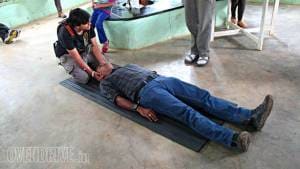Why slow riders might be happier riding fast bikes
This column originates in the wonderful discussion - yes, including cynicism and accusations of bias - that followed my Royal Enfield Himalayan versus Mahindra Mojo versus KTM 200 Duke story. I'd claimed that Royal Enfield should've given the Himalayan five, ideally 10 more horses. That would have turned a friendly, good motorcycle into the toast of the segment, even if the price was higher. In response to that, one reader commented: "Not everyone wants to ride fast, at least not everyday!"
That makes sense, right? I agree. But I think there is a nuance to that which most riders won't fully understand until they spend some time with a fast motorcycle. I thought I'd try to explain the difference between slow and fast motorcycles and discuss why fast motorcycles can be far better at going slow than slow motorcycles can in many cases.

Before we go into the nuance, let's get one thing very clear. Fast motorcycles can usually go slow. Slow motorcycle cannot go fast. This isn't clever word play. This is a fact.
A skilled rider will extract more speed from a slow motorcycle (and also from a fast one). There is definitely something to said for being able to ride a slow machine fast. It feels great and is seriously rewarding. It's also a lot of work, and some of that feeling comes from knowing how much at risk you were. But fundamentally, a faster machine implies a greater speed range - it gives you more options.
Now to the little things that make going slowly on a fast bike so nice.
1. Faster bikes are usually lighter
The most effective way to produce more performance is to lose weight. This is true for more than just motorcycles, ahem. Lower weight produces greater acceleration as well as top speed, and it improves economy as well. In the Indian context, motorcycles built for performance tend to use better, advanced materials and aggregates that create lighter machines. The important thing is that at slow speeds, especially at super slow speeds, light machines are typically easier to wield than heavier ones. Faster machines also deploy their weight better and that can often make them stunningly easy to ride.
2. Faster bikes stop better
The most powerful thing on your motorcycle isn't the engine; it's the brakes. Once again, faster motorcycles, typically, come with better, more effective equipment. They're more likely to have feelsome brakes, ABS and superior outright stopping power. They also - and this is a big one in my books - get better tyres and that changes everything.
3. Bigger safety margins
Because a fast bike is designed to go, erm, fast, it has to have greater capabilities in every direction. More speed, more responses, more everything. Yes, that can and mostly does include price too. But you already know what I think about money.
The point is simple. It means that at a relatively mild speed, say, 50kmph, you run a far bigger reserve/safety margin on a 200kmph motorcycle than on something designed to max out at 98kmph. These reserves could be your tools when you need to build an escape path out of a scary situation. A slight thing here is that when you're far from the edge of performance, most riders feel confident and in control. In my experience, riders who feel like this tend to ride better automatically. In fact, at the TWO School run by Indimotard and OVERDRIVE, raising the speeds at which you remain confident is part of the curriculum.
4. Faster bikes promote rider control
This hadn't occurred to me when I wrote my initial comment. The underlying idea is that power, as Pirelli reminds us constantly, is nothing without control.
By nature, fast motorcycles have to allow excellent control (mechanical or electronic) over their power and dynamics. If they don't, they get billed as scary, widow-makers and what have you. One point to note here is that scary motorcycles tend not to automatically put off many motorcycle riders. By and large, riders prefer to ride machines that thrill and allow you to control them. Fast machines work hard at precision and feedback, both of which are critical to your sense of control over them.
The point is that slow motorcycles can be nice, but they are limiting. And when you are considering buying one, especially, a touring machine, you should be looking at something fast. Touring riders will usually average between 50-90kmph. Only a few can manage sustained average speeds higher than 90kmph while riding smoothly and safely - and that too on a handful of roads in India. Technically, then, almost any 125cc motorcycle should tour.
Then why do touring riders looks for significantly larger machines? Even in India where "Where are the roads?", "Shaddap, you cannot cross 60 anywhere!" and "Tsk tsk, you should move to Europe if you want ride so fast!" are common refrains.
I believe that averaging 90kmph, or holding a steady 100kmph down the highway requires a machine that will do between 150-170kmph flat out. The cruise speed needs to be just above half way in the performance band, ideally around the peak torque point in top gear. These machines will make the steady 100kmph utterly, effortlessly blissful. Big miles will pass sweetly under their wheels, and their riders will arrive fresh, elated and bursting with energy. These are the machines that you'll fall in love with.
The final point is deeply personal. I've ridden a lot of slow bikes and a lot of fast bikes. There are a few slow ones that have proved to be unexpectedly good. But if you're looking to have fun (that's what motorcycles are about, right?), fast bikes are far and away more fun to ride than slow ones.
Let me know what you think in the comments below!












